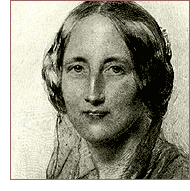 Elizabeth Gaskell
Elizabeth Gaskell
1810-1865
Tremendously popular in her lifetime, Elizabeth Gaskell now tends to be
overshadowed by the Brontės and George Eliot. Cranford (1853) and Wives
and Daughters (1866) have been the most acclaimed of her works, although
today Mary Barton (1848), her first novel, and North and South
(1855) receive more critical attention. The two pairs of novels represent
Gaskell's prevailing interests as an author: provincial life and urban issues. In
all of her writing, Gaskell was concerned with how individual lives play out
against the pressures of history and social life.
Gaskell was the daughter and wife of Unitarian ministers. Born in London, the
infant Elizabeth Cleghorn Stevenson was sent, after the death of her mother, to
live with an aunt in the Cheshire village of Knutsford, which would become the
model for Cranford and for Hollingford in Wives and Daughters. After her
father's death, she visited the urban centers of London, Newcastle, Edinburgh,
and Manchester, and it was in Manchester that she met and married William
Gaskell in 1832.
Out of her observations of the Manchester poor came Mary Barton, which
was one of an array of novels written in the 1830s and 1840s that brought the
miserable living conditions of the working poor to the public's attention. Along
with Dickens, Benjamin Disraeli, Charles Kingsley, and Charlotte Brontė (in
1849's Shirley), Gaskell wrote of the "Condition of England." Coming
from different points on the reform spectrum, these authors borrowed from the
emerging field of sociology (Friedrich Engels's The Condition of the Working
Class in England was first published in 1844) to document the problems of
poverty with the goal of social change in mind. Although northern
industrialists opposed Gaskell's representation of the exploitative rich and
the working poor, and some critics charged her with overly broad
characterization, Mary Barton was immediately successful and brought
Gaskell fame as a writer.
With Cranford's serialization from 1851 to 1853, she became affiliated
with Dickens's magazine Household Words. Something of a celebrity in
England, Gaskell lent her support to raising funds for her friend Florence
Nightingale's work in the Crimea in 1854. The following year, Gaskell was asked
by the father of Charlotte Brontė (also her friend) to write her biography. Published
in 1857, Life of Charlotte Brontė received the support of Brontė's
widower but was challenged by other parties concerned in it. Despite this blot
on her literary reputation, Gaskell continued to write until her sudden death
in 1865, with Wives and Daughters serialized into 1866.
Elizabeth
Gaskell Windows Internet Explorer
20 Octubre
de 2008, 19:13
URL: http://www.pbs.org/wgbh/masterpiece/wives/writers/gaskell.html
Academic year
2008/2009
© a.r.e.a./Dr.Vicente Forés López
© Natalia Quintana Morįn
naquinmo@alumni.uv.es
Universitat de Valčncia Press
Ž MORE BIOGRAPHIES: [1] [2] [3] [4] [5] [6] [7] [8] [9] [10] [11] [12] [13] [14]